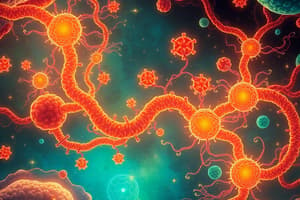Podcast
Questions and Answers
What is produced from pyruvate in the presence of oxygen?
What is produced from pyruvate in the presence of oxygen?
Acetyl CoA, NADH, H+, and CO2
How many NADH are produced by glycolysis?
How many NADH are produced by glycolysis?
2
What are the products of the citric acid cycle?
What are the products of the citric acid cycle?
3 NADH + 1 ATP + 1 FADH2 + 2 CO2
What is the net gain of glycolysis?
What is the net gain of glycolysis?
What are the inputs into glycolysis?
What are the inputs into glycolysis?
What are the outputs from glycolysis?
What are the outputs from glycolysis?
What does the electron transport chain achieve?
What does the electron transport chain achieve?
During the energy investment phase: Glucose + 2 ATP = ?
During the energy investment phase: Glucose + 2 ATP = ?
During energy payoff phase: 2 Glyceraldehyde-3-P + 4 ADP + 2 Pi + 2 NAD+ -->
During energy payoff phase: 2 Glyceraldehyde-3-P + 4 ADP + 2 Pi + 2 NAD+ -->
What is glycolysis?
What is glycolysis?
How much energy in the form of ATP and NADH is obtained by glycolysis?
How much energy in the form of ATP and NADH is obtained by glycolysis?
Flashcards are hidden until you start studying
Study Notes
Glycolysis Overview
- Glycolysis breaks down glucose into two molecules of glyceraldehyde-3-phosphate, eventually converting them into two pyruvate molecules.
- Key outputs include 2 ATP, 2 NADH, and 2 pyruvate, effectively generating energy.
Inputs of Glycolysis
- Inputs required for glycolysis are glucose, 2 NAD+, 2 ATP, 4 ADP, and 2 inorganic phosphates (Pi).
Outputs of Glycolysis
- Outputs generated by glycolysis include 2 pyruvate, 2 NADH, 4 ATP, and 2 ADP.
- Net gain during glycolysis is 2 ATP and 2 NADH, alongside 2 pyruvate.
Citric Acid Cycle (Krebs Cycle) Overview
- Involves the conversion of pyruvate into acetyl CoA, producing CO2, NADH, and H+.
- Efficiency includes outputs of 3 NADH, 1 ATP, 1 FADH2, and 2 CO2 per cycle.
NADH Production
- Glycolysis produces 2 NADH molecules.
Energy Investment vs. Payoff Phases
- Energy investment phase: Glucose + 2 ATP converts into 2 glyceraldehyde-3-P + 2 ADP.
- Energy payoff phase: Transforms 2 glyceraldehyde-3-P into 2 pyruvate, producing 4 ATP and 2 NADH.
Electron Transport Chain (ETC)
- Reducers NADH and FADH2 release energy, powering H+ ion pumps in the inner membrane.
- Creates an electrochemical gradient, essential for ATP synthesis via ATP synthase.
- Process of ATP synthesis driven by H+ diffusion is known as chemiosmosis.
Energy Yield from Glycolysis
- Total energy yield from glycolysis is approximately 500 kJ.
Acetyl CoA Formation
- Pyruvate conversion into acetyl CoA involves loss of one carbon as CO2, oxidation to acetate, and bonding with coenzyme A.
Studying That Suits You
Use AI to generate personalized quizzes and flashcards to suit your learning preferences.





